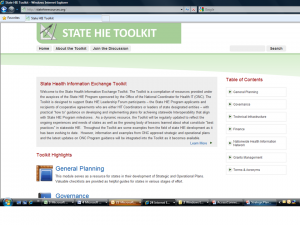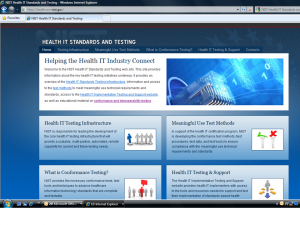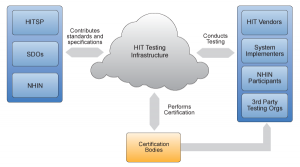HHS Announces Additional $162 Million in Recovery Act Investment to Advance Widespread Meaningful Use of Health IT
HHS Press Release: March 15, 2010
Final awards of state health information exchange cooperative agreement program work to build health information exchange infrastructure throughout the states
(Alaska, Connecticut, Florida, Idaho, Indiana, Iowa, Louisiana, Maryland, Mississippi, Montana, Nebraska, New Jersey, North Dakota, South Carolina, South Dakota, Texas.)
U.S. Department of Health and Human Services Secretary Kathleen Sebelius today announced awards to help states facilitate health information exchange and advance health information technology (health IT). Funded by the American Recovery and Reinvestment Act of 2009, today’s awards are part of the $2 billion effort to achieve widespread meaningful use of health IT and provide use of an electronic health record by every citizen by the year 2014. Every state and eligible territory has now been awarded funds under this program.
“These critical investments will help unleash the power of health information technology to cut costs, eliminate paperwork, and help doctors deliver high-quality, coordinated care to patients,” said Secretary Sebelius. “States are important partners in improving and expanding our electronic health records system. By improving the secure exchange of electronic health records between providers and hospitals within and across states, these awards mark a significant step in bringing our health system into the 21st century.”
The health information exchange HIE awards announced today provide approximately $162 million to 16 states and qualified state designated entities (SDEs) to facilitate non-proprietary health information exchange that adheres to national standards. Health information exchange is critical to enabling care coordination and improving the quality and efficiency of health care.
“Today’s announcement of awards to 16 states and SDEs marks a significant milestone with all states now empowered to start their journey towards identifying innovative ways to break down theses barriers that prevent the seamless exchange of information, so that we can give patients the access to care they deserve and expect,” stated Dr. David Blumenthal, national coordinator for health information technology. “States play a critical leadership role in advancing the development of the exchange capacity of healthcare providers and hospitals within their states and across the nation. Health information exchange will enable eligible healthcare providers to be deemed meaningful users of health IT and receive incentive payments under the Medicare and Medicaid electronic health record (EHR) incentive program.”
These cooperative agreements were awarded under the authority of Title XIII of ARRA, the Health Information Technology for Economic and Clinical Health (HITECH) Act which amends Title XXX of the Public Health Service Act by adding Section 3013, State Grants to Promote Health Information Technology. Section 3013 provides for the awarding of competitive grants to promote health information technology. On February 12, 2010, HHS awarded $385 million to 40 states and SDEs. The awards announced today complete the awarding of cooperative agreements funded by this program.
A listing of the state HIE competitive agreements announced today follow:
| State/SDE |
Award Amount |
| Agency of Health Care Administration (FL) |
$20,738,582 |
| The Maryland Department of Health and Mental Hygiene |
$9,313,924 |
| New Jersey Health Care Facilities Financing Authority |
$11,408,594 |
| South Carolina Department of Health & Human Services |
$9,576,408 |
| Iowa Department of Public Health |
$8,375,000 |
| Idaho Health Data Exchange |
$5,940,500 |
| State of North Dakota, Information Technology Department |
$5,343,733 |
| State of Alaska |
$4,963,063 |
| Nebraska Department of Administrative Services |
$6,837,180 |
| South Dakota Department of Health |
$6,081,750 |
| Department of Public Health, State of CT |
$7,297,930 |
| State of Mississippi |
$10,387,000 |
| Indiana Health Information Technology, Inc. |
$10,300,000 |
| HealthShare Montana |
$5,767,926 |
| Texas Health and Human Services Commission |
$28,810,208 |
| Louisiana Health Care Quality Forum |
$10,583,000 |
| Total |
$161,724,798 |
Recovery and Reinvestment Act of 2009 can be found here: http://HealthIT.HHS.gov
For more information about the Recovery Act, please visit: www.hhs.gov/recovery and www.recovery.gov
# # #
Blumenthal Adds Post to ONC Health IT Buzz Blog
“A Key Step Toward Nationwide Health Information Exchange”
On March 15, 2009, National Coordinator for Health IT, Dr. David Blumenthal wrote “As part of this round of awards, 16 states and qualified State Designated Entities (SDE) will obtain the resources and technical assistance to rapidly build capacity for exchanging health information among and between health care professionals and hospitals. Such exchange will allow any two providers in a state – and ultimately across the nation – send and receive relevant clinical and other data necessary for improved coordination of patient care. Recipients of these awards will establish and implement appropriate governance and policies and ensure the necessary technical infrastructure and business operations are in place to support secure exchange within and across states.
“An unprecedented level of coordination and collaboration is needed to achieve our vision of a secure, interoperable, nationwide health information infrastructure where health data can follow patients to their point of care. We must find innovative ways to break down the barriers that prevent the seamless exchange of information, and States have to be key players.
“I congratulate each grant recipient, and welcome a dialog on the role of states in advancing our challenging agenda.”
HHS Press Release
ONC: State HIE Cooperative Agreement Program Page
“In March 2010, ONC completed the announcement of State Health Information (State HIE) Exchange Cooperative Agreement Program awardees. In total, 56 states, eligible territories, and qualified State Designated Entities (SDE) received awards.
“The State HIE Cooperative Agreement Program funds states’ efforts to rapidly build capacity for exchanging health information across the health care system both within and across states. Awardees are responsible for increasing connectivity and enabling patient-centric information flow to improve the quality and efficiency of care. Key to this is the continual evolution and advancement of necessary governance, policies, technical services, business operations, and financing mechanisms for HIE over each state, territory, and SDE’s four-year performance period. This program is building on existing efforts to advance regional and state-level health information exchange while moving toward nationwide interoperability.”
Additional Facts and Resources from ONC Site
Facts-At-A-Glance
Frequently Asked Questions
State HIE Toolkit
Original Funding Announcement Information




